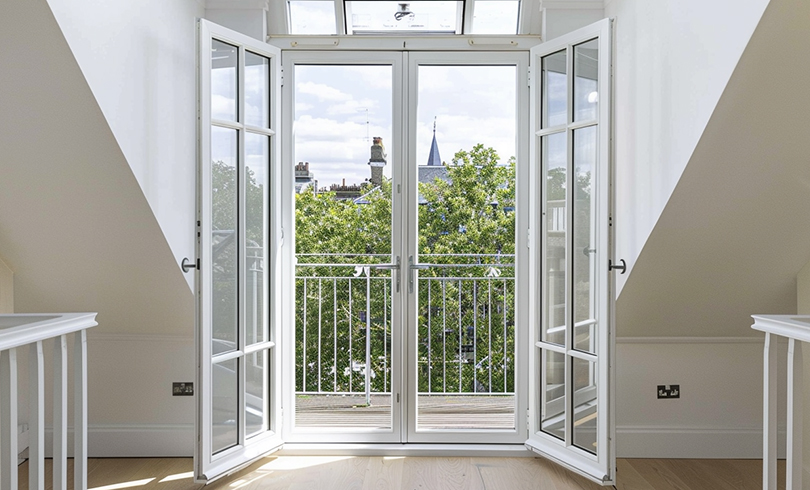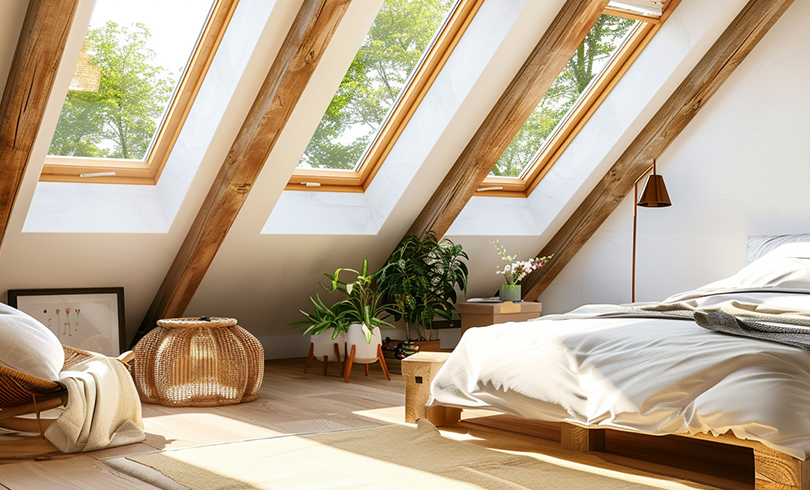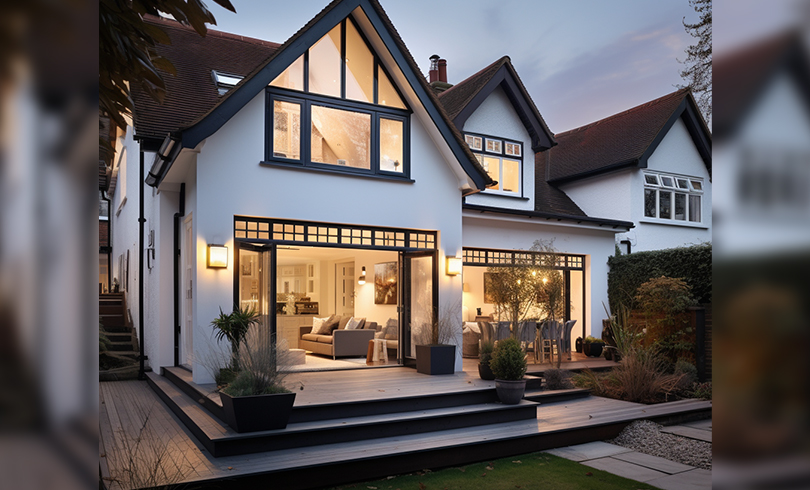
Planning to move? Why not improve? It is always convenient and affordable to extend the existing house rather than shifting to a new house. Mansard Loft conversion helps add that extra room from the unused attic space in your home and makes your home look bigger, stylish, and amazingly spacious. Discover this ultimate guide on mansard loft conversion that covers everything from meaning, types, planning permissions, benefits and more.
Mansard loft conversion is an ideal choice when it comes to extra-functional space, aesthetic appeal and added monetary value. Keep reading to find out everything you want to know about mansard loft conversion in London.
- Introduction
- What is a Mansard loft conversion?
- Types of Mansard loft conversion
- Benefits of Mansard loft conversion
- Planning Permission for a mansard loft conversion
- What are the loft conversion building regulations?
- How much does a Mansard loft conversion cost?
- How is Mansard roof loft conversion performed?
- How long does a mansard loft conversion take to build?
- What other things do you need to make Mansard Loft Conversion?
- Pros and Cons of loft conversion mansard
- What living areas can I create with a Mansard loft conversion?
- Is my home suitable for mansard roof loft conversion?
- The Bottom Line
- Frequently Asked Questions
What is a Mansard loft conversion
A mansard loft conversion involves giving two pitches to the sloping roof. The top of the roof is less steep while the sides are extremely steep. Typically, the roof is either flat or equivalent to a flat roof. This helps you add an extra floor to the existing property with dormer windows. All four sides of a mansard roof have two sloping roofs of which one is steeper than the other. This loft conversion is usually done on the rear side of the property. One of the walls is removed and the height of the party wall is raised to create more space. The new roof slopes have almost a vertical slope of no less than 72 degrees.
Types of Mansard loft conversion
A mansard roof is one of the most aesthetically appealing among all loft conversions. The reason is it doesn’t appear as a box-like dormer as well as flushes out those gable ends. Mansard loft conversion completely alters the slope of the roof to an angle of 72 degrees. Mansard loft conversions are mostly suitable for terraced houses in highly populated areas.
According to design and functionality, mansard roof designs can be altered or modified into the following designs. Have a look.
- Concave Style mansard roof: This type of roof is inspired by the concave design. The lower slope is curved inside, and a steep angle is given at the bottom. This type of mansard design is commonly used in mansions and buildings but is quite expensive in terms of maintenance and repairs.
- Convex Style mansard roof: This is opposite to concave style. Here the lower roof is curved outwards. The design looks like the English letter “S.” This shape ensures more internal space than other shapes. The main pre-requisite for this shape is that you need to be sure that there aren’t any trees or branches intruding on the area. The convex style is generally found on courthouses, towers, and hotels.
- Straight Style mansard roof: It’s more like a standard mansard roof loft conversion. They have a nearly flat or a slight slope in the upper part. And dormer windows are housed on the lower slope. Dormer windows make the space well-ventilated as well as are good for lighting and extra space.
- L-shaped mansard loft conversion: l-shaped mansard loft conversion significantly adds value and space to the property. This loft conversion may not be possible and feasible for all the properties. The properties often built under planning permission or some Victorian ones, are often considered to undergo l-shaped mansard loft conversion to match the surroundings. This loft conversion is mainly possible at the rear of the property i.e., extension over kitchen and bathroom.
- Double mansard loft conversion: Double mansard loft conversion is like a standard mansard roof with just the difference that it is done in the front as well. The front and rear mansards together form a double mansard loft conversion and are one of the largest loft conversions available.
Benefits of Mansard loft conversion
Delve into the magical and beautiful experience of transforming your unused space into a spacious living area by undergoing a mansard roof loft conversion. Now, make your dream of having an extra bedroom(s) with an attached bathroom come true with this roof conversion. Check out the benefits:
- Exceptional attic space: As compared to the other roof loft conversions such as dormer, gable, Velux etc, Mansard roofs offer a good space dimension as it has a close to vertical bottom pitch. You can easily add a master bedroom with an ensuite along and an additional space for a living room. This is possible because of the good head height as well as double-pitched slopes. Dormer windows can easily be added for increased sunlight and turn the room bright and shiny.
- Aesthetic Value: Mansard roof loft conversion turns the space elegant, and modern with a touch of sophistication. Mansard roofs were an important part of French architecture, this made it more unique.
- Easier to expand: Mansard roof loft conversion opens the gates of flexibility to expand. Mansard roof conversion doesn’t require much structural reinforcement. As the bottom slope is close to vertical, further addition of new floors becomes less complicated as compared to other roof loft conversions such as hip to gable.
- Works well in all areas: These roofs are versatile. Whether it’s rural or urban, mansard loft conversionworks brilliantly well in all areas due to the extra space offered and its ability to expand. The straight mansard walls are easier to furnish than the sloping roofs of other loft conversions.
Planning Permission for a mansard loft conversion
Mansard loft conversion always requires planning permission. Undergoing a mansard loft conversion means alerting the pitch of the roof till the top is flat or the walls are almost vertical. As a major portion of structural alterations is involved, mansard loft conversions do require planning permission. Apart from that, it will also need to comply with building regulations and be inspected by local authorities. In case the alterations may impact the adjoining properties, a Party Wall Agreement may be required. The construction cannot be started until the approval has been gained and may take up to 8 weeks to get the approval. The mansard conversions are visually less imposing; therefore, these are more likely and easily granted planning permission for people living in the conservation area.
- How much does planning permission cost? – For applying to planning permission for your loft conversion, you need to pay an application fee. The costs of planning permission vary from place to place. The fee generally starts from £202 in England for all the extensions and alterations made to a single dwelling house.
- How long does planning permission take and how long does it last? – The local authorities are bound to share a reply as soon as possible. For a simple application, the applicants can expect a response within eight weeks. It may take up to 13 weeks for complex applications. If an application involves carrying out an environmental aspect assessment, 16 weeks can be expected for the application to be processed. Until specified, the notices from planning permission are valid for three years from the date of grant. The applicant can start anytime within this three-year time, anyhow the work can be completed after three years. If any short, long, or specific time has been granted, it would be stated on the letter of approval.
What are the loft conversion building regulations?
Building regulations play a key role in deciding whether the loft conversion is stable or not and ensuring that the structural integrity of the building is not hampered. Irrespective of the type of loft, every conversion has to comply with the building regulations. Depending on the type of extension you are planning, you need to be aware of the respective building regulations for loft conversions.
- Building Regulations for planning for storage space – Even if you want to convert your unusable attic space for storage purposes, you need to get approval from the local authorities regarding compliance with building regulations. Mostly, the joists of the ceiling of the rooms below (attic floor) are not designed to bear any weight. Putting excessive weight on the can affect the overall strength of the property. So, it’s necessary to get the design approved by the building regulations to ensure additional safety.
- Building Regulation for planning a habitable space – Converting your unused attic space into a liveable space also requires you to get approval from the local authorities. Whether full or partial, loft conversions do need a lot of alterations to be made. Complying with building regulations ensures maintaining the structural integrity and safety of the occupants as well. Each and every step of the loft conversion should be inspected and approved by the Local Authority Building Control department and signed off. All the following categories of building regulations must be complied with to get approval. – Headroom (> 2.2 m), Proper Insulation, Fire and Electrical Safety, Staircase and Stairs Design, Sound and Water Proofing, and Structural Integrity.
How much does a Mansard loft conversion cost?
A loft conversion mansard gives you a completely new storey over your existing property. It’s a complicated and massive building alteration. The cost depends on:
- The scale of the work
- Design
- Style and finish
- Additional spaces such as a bathroom
In general, the bigger the property, higher the price. The mansard loft conversion cost starts from £50,000 to can go up to £70,000. The cost is pretty high from other conversions such as hip to gable or dormer as it involves changing the entire structure of the roof. But every penny spent is worth the investment made.
How does location affect the loft conversion cost?
There is no one-size-fits-all approach for the cost prediction. Typically, the cost of construction depends a lot on the market prices of the property. If the property prices are lower, the construction works are affordable and vice versa. The location of the property is also one of the deciding factors for your loft conversion cost. The more the locality is densely populated, busy, and deeply inhabited, the higher the costs. The reasons for the high costs are due to:
- Space constraints in a metropolitan city raise the cost as there is very little space available for parking, scaffolding, machinery set up etc.
- The cost of labour in such areas is pretty high as the workers are getting good daily wages or salaries.
- The transportation and materials costs are high as the production plants are far away from the metropolitan areas.
How is Mansard roof loft conversion performed?
Mansard roof loft conversions are indeed one of the most complex and expensive than other similar conversions because they involve a complete makeover of the internal roof space. Check out the steps involved:
- Step1: The existing roof is removed.
- Step2: Party walls are raised in height.
- Step3: Interior walls are created.
- Step4: A new roof is constructed at a different angle.
- Step5: Dormer windows and access points (staircase) are added.
Scaffolding is created to work externally. Apart from that, to continue the work in bad weather, a roof cover is needed. Along with roof construction, the existing attic floor will be strengthened. All the plumbing and electrical connections are added. Once your entire work is inspected and approved as per the building regulations, you are all set to furnish and decorate your new living space.
How long does a mansard loft conversion take to build?
Around 8 to 12 weeks are required to convert your normal-looking roof to a mansard roof. Time also depends on the architectural design and size of the property. Mansards are quickly becoming popular in the London area as they add a whopping 20% increase in your property value. A mansard roof loft conversion is a great investment giving you the ultimate headspace and adding usable living space to your home.
What other things do you need to make Mansard Loft Conversion?
- Look around your neighbourhood: Just step out in your locality and find if any house in your locality has undergone mansard loft conversion. If you find one, approach the owner and have a look from the inside and make your brain cells visualize your home regarding this conversion.
- Measure headspace: The minimum headspace required for any type of loft conversion is 2.2 m. The best way to measure it is by using a measuring tape and running it from the floor to the tallest part of the ceiling. If it is 2.2m or more, then your loft is suitable for conversion. There is a possibility that some homes such as Victorian homes that were built before 1930 may not have that much headroom.
- Roof type: A lot of things depend on the type of roof you have. Whether it’s newly built, old or whether your roof has rafters or trusses etc. One can easily tell a lot about the roof by looking at the loft hatch. Mansard loft conversion with trusses is possible but additional support would be required to replace the trusses. This can ultimately affect the overall cost.
- Consider the floor below: Most people ignore the changes that will be made to the floor post-conversion. Placing, even a staircase in a minimal way could take a sizable chunk of the room. Make sure you are happy to lose that space!
Pros and Cons of loft conversion mansard
Pros:
- A loft conversion mansard adds a new storey to your property making it more spacious.
- All types of properties are eligible to undergo mansard loft conversion until they comply with building regulations.
- Versatile and can be matched up with the existing style of the building.
- Gives a “room in the roof.”
Cons:
- Mansard conversions are indeed an expensive option than other loft conversions.
- Requires planning permissions for mansard conversion while for other types, they fall under permitted development rights.
- Requires a good amount of construction work.
What living areas can I create with a Mansard loft conversion?
Getting a mansard loft conversion offers an ample amount of living and habitable space. You can create a multifunctional space that suits your lifestyle and requirements. Some options include:
- Bedroom with ensuite bathroom and dressing room
- Hobby Room, living room
- Kids and play area
- Gym, Home cinema, Music room, dance room
- Office
- Teenage den
Is my home suitable for mansard roof loft conversion?
The best part of mansard loft conversions is that they are suitable for all home types, be it semi-detached, detached, terraced homes, chalets, or bungalows. It is best suited to properties where the space on the side and rear of the homes is restricted, and the homeowners don’t want to use the garden space by adding a ground floor extension. Modern semi or Victorian townhouse, loft conversion mansard is now a common feature seen in densely populated, urban, and suburban areas. The residents just love to bring out the aesthetics of the external walls by going for cladding with tiles or slate or brickwork- whatever makes them exclaim “wow.”
The Bottom Line
Mansard loft conversions are best suited for properties in densely populated areas where there are space constraints to expand the property in front or rear. Mansards are great for adding a whole storey and carving out a beautiful living space from the unused attic space. The space can be used as office space, guest area, playroom, lounge, or extra bedrooms! A mansard conversion involves restructuring the slopes into two pitches where one is steeper than the other. It’s more like an extension than a conversion.
TEL Constructions is the leading and experienced loft conversion company offering bespoke loft solutions across the UK for over a decade. From start to finish, we offer end-to-end services for your mansard loft conversion. We are registered builders of Federation of Master Builders (FMB) and members of Trustmark. Looking for innovative mansard loft conversion ideas? Connect with us and request a free quote or site visit today!
Here’s What Our Clients Say



